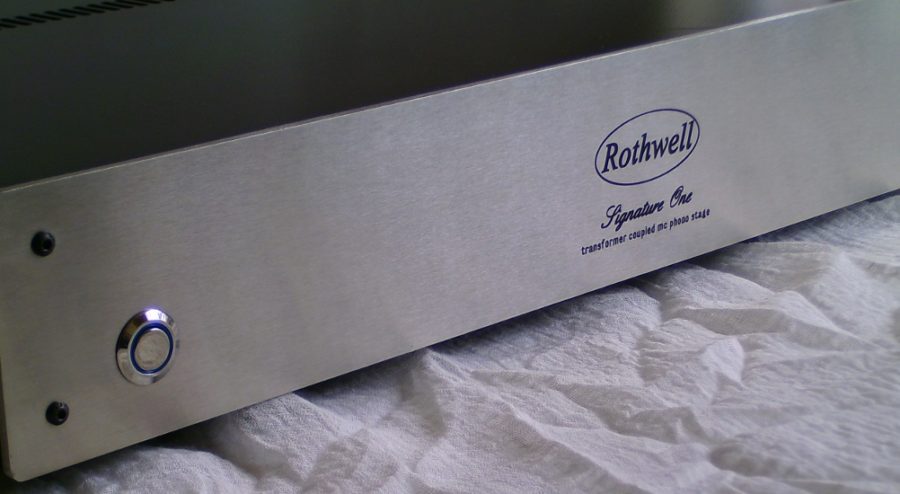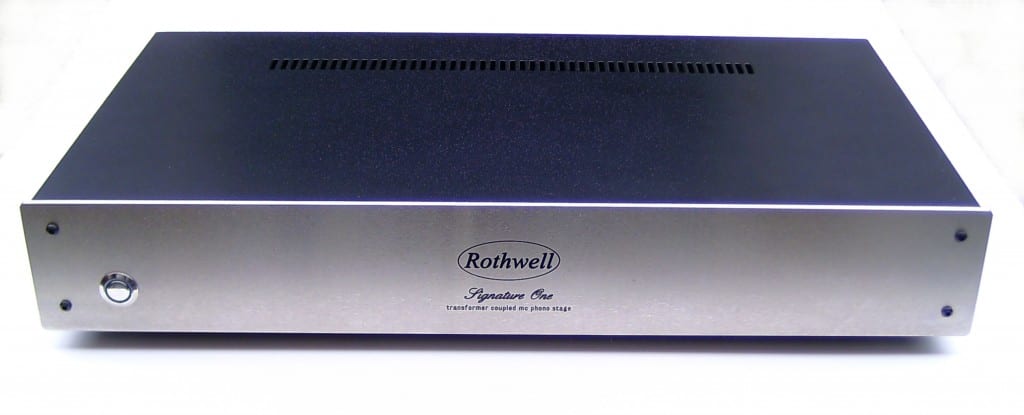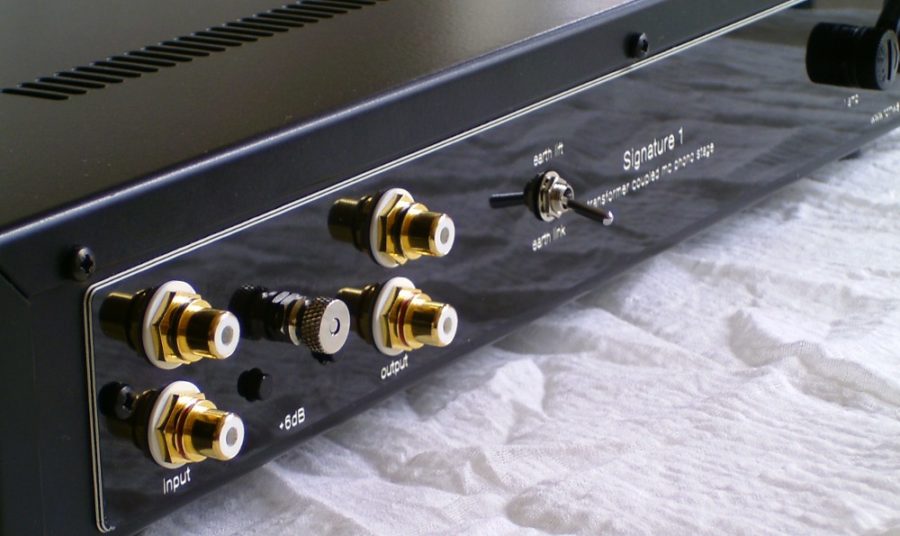Janine Elliot takes a listen to the £2200 Signature One transformer coupled Moving Coil Phono-Stage from well known British manufacturer Rothwell.
I love Class A and large toroidal transformers, and if you have followed my reviews over the years you will know my love for anything passive. So, to be offered a chance to listen to a moving-coil phono-stage with Class A amplification and capacitor-based RIAA EQ was like being offered my favourite ice-cream. Rothwell-designed products date back to 1989, and have included step-up transformers, attenuators, phono-stages and passive preamplifiers.
Set up by Andrew Rothwell, like many manufacturers a budding musician learning classical guitar repertoire at a young age and with a love of rock and later jazz, he went on to study a degree in physics and working as an electronics engineer for British Aerospace. His interest in music and professional music technology (there’s not much of that on ships and planes) influenced his decision to leave this career and ultimately designing his Indus passive preamplifier in 1989, something he did after being disillusioned by the sound quality of some “high-end” active products on the market. And, whilst the world turned to everything transistor, his first experiments with a valve phono-stage were positive proof for him, and many other cottage industries, that valves were, and still are, better. Whilst not the earliest, the first Rothwell standalone phono-stage came at a time before such products were the norm, and his current catalogue boasts no fewer than seven phono related products.
The Signature is a high-gain moving-coil phono-stage, offering switchable 6dB gain selecting either 62 or 68dB gain, with a switch at the rear for 1:10 or 1:20 transformer turn ratio catering for input load of 470Ω or 117Ω, allowing the majority of cartridges to be well catered for. My Kontrupunkt b works best at a little above 100Ω, so the latter setting was found best for my audition purposes. The refined looking blue illuminating off/on front button relies on a smaller finger than mine to switch it on, which whilst a lovely looker took me a while to get used to as you need to literally push in the middle of the button. But once I mastered this, (the light is also a bit weak for me, but most will find it OK. It reminded me of the touch sensitive lights on the Philips GA212 turntable I had in the 70’s) my initial thoughts was the openness and silky smooth refined sound, as plush as the classy-looking silver front and black sleeved unit it came in. This didn’t mean it wasn’t clear. Far from it. Muse’s Drones album is still very energetic but not out of control or rough. “Mercy” was indeed compassionate in its delivery and the triple ribbon speakers in the Zeta Zero Piccolo speakers up for review had a sheen making for a tireless performance. Detail in Mike Valentine’s ‘Big Band Spectacular’ featuring The Syd Lawrence Orchestra and the legendary track “In the Mood” (Glen Miller), was all there and very clear. The sound was set back, rather than forward like many phono-stages, allowing for a good depth of sound allowing the orchestra to sit clearly in my living room, with the solo saxophone and then trumpet in “Little Brown Jug” to take front of stage when their time came. I started to really enter the recording studio live-area as I listened, rather than being in front of loudspeakers, which is after all the aim of all serious hifi designers. And whilst I loved what I heard I did feel it was still just a very little too laid back for me. Soundstage was as good as it gets, and the velvety performance I know will find many devotees.
The use of exceptional Swedish Lundahl transformers coupling and a capacitor-based passive EQ stage shows why this can beat even the very best of valve and transistor behemoths. Moving coils, even high output MC’s, are still very low-output generators, less than 10% of moving magnets, and therefore require circuits with a very good noise floor, something a transformer cannot be bettered for. This Rothwell is a very quiet baby, only requiring me to ensure I earth it really well to remove the very minutest hum, and with earth lift/earth link switch I could select my preference. The core material for the transformer itself is a cobalt based uncut amorphous strip which gives a high inductance factor (to extend the low frequency bandwidth) without the need for an excessive number of turns of wire, which in turn keeps the winding resistance, and hence noise, low. The coil itself has unusual inter-winding geometry to keep capacitance low, which extends the high frequency bandwidth and minimising ringing. This design also benefits from rejecting interference from external stray magnetic fields and therefore minimises hum.
For the first active circuitry a Class A amplifier is chosen, since it offers the purest and simplest circuitry, free from crossover distortion and nasty little op-amps often employed in a Class A/B design. After this is the passive RIAA EQ which utilises audiophile polypropylene capacitors. This is followed by a second active gain stage with a compound transistor configured output buffer for low output impedance and low distortion.
As well as exceptional noise floor, the extended frequency bandwidth provided me with a sound that just lit up my face with smiles. This was like home-made full fat ice-cream. Only when pushed a bit with complex mid-high frequencies did it sound slightly like a little bit of lemon sorbet, for example Pink Floyd ‘The Division Bell’ track “Cluster 1”, after matching output level, was a lot more powerful in performance at 117Ω than the low gain 470 Ω input, where the sound was less cluttered largely because the higher impedance opens the sound more giving the better top end and stereo at the expense of accuracy, especially in the bass. Having a switch to adjust to your cartridge is one thing, but this had two, one for each channel, which did surprise me somewhat, though I guess it was to do with performance and certainly not ergonomics. Perhaps there should be two on-off switches, one for each leg. Setting the best load for your cartridge is absolutely vital if you want the correct sound from your cartridge and certainly a “one fits all” isn’t likely to be the best move, as seen in some 5-figure offerings out there. So, two different settings as in the Rothwell are helpful, though I always personally favour phono-stages with variable impedance and capacitance. At £2200 I would like more settings. This is only a slight criticism as I couldn’t quite get the setting that is best for my Kontrapunkt .
For me, the Signature One just wasn’t quite as controled in its delivery as some phono-stages when mid/high frequencies were energetic. Pink Floyd ‘The Division Bell’ offered everything, but just not quite controlled enough when excited for me to give it that 9+. Floyd’s ‘Marooned’ ride cymbals were very clear, but bass and kick drum didn’t give enough authority to warrant that top mark. Clarity in the tops allowed for a great sound-stage, but David Gilmour’s voice lacked grunt I know I can get from my phono-stage of choice, though I have to admit that is substantially more expensive.
The ideal phono-stage shouldn’t leave a signature, and this Signature One is very neutral for most of my listening; only a few times sounding a bit like a panicking teacher when faced with the most unruly brats. The accompanying blurb claims the sound to be ‘simply unrivalled’, which is always a dangerous statement to make, and whilst the leaflet is a last thought, with several typos and perhaps missing a picture to show connections, it is not short of looks and design innovations. Rothwell’s CV also includes some amazing guitar pedals (I also play the guitar) with titles such as “F1 Booster”, “Atomic Booster”, “Hellbender” and “Tornado”, and I only wish he had put a bit of the titles of some of these products into the Signature One’s recipe; then it would have been up with the very best of them, at any price.
CONCLUSION
My job as a reviewer can be frustrating. Whilst I so want to give everything I hear that very top mark, I need to be critical, and so I very, very rarely give anything 9 unless it absolutely the best. This is a truly good product showing that the thought into, and physics of, the design really do work, and I have no qualms in suggesting you listen to this product, certainly if you want that purity and ease of performance. Some might find it just a little too relaxed and then panicking slightly with complex input, but what it can do, unlike many phono-stages is to be as happy on classical and jazz as it is with heavy rock. Now, that is something to be very proud of.
Value for Money – 8.6/10
Build Quality – 8.5/10
Overall – 8.63/10
Pros:
Mostly neutral
Ease of performance
Good with a wide range of genres
Cons:
Can get a little too relaxed and panicky with complex material in the mid-high frequency range
Janine Elliot
Designer’s Comments
Obviously, the primary design decision behind the Signature One was to use on-board step-up transformers. In my experience you can’t beat transformer coupling low output moving coils. It isn’t a popular way to go for manufacturers because it’s considerably more costly than using op-amps or transistors, and most audiophiles are wary of using step-up transformers at all, probably based on ugly rumours circulating on forums, but I wanted to produce a great-sounding phonostage and demonstrate the benefits of step-up transformers in a convenient one-box package. The on-board step-up transformers in the Signature One can be set for ratios of 1:10 and 1:20 so the vast majority of modern MCs can be accommodated. They are supplied by Lundahl and are superb.
The next design decision was to use discrete transistor circuitry. Although op-amps have become ubiquitous throughout the hi-fi industry, the fact that they have class B output stages seems to be overlooked. They’re very much like Class B transistor power amps, but in miniature, and suffer from crossover distortion in a similar way to power amps. Large amounts of negative feedback are used to reduce the crossover distortion, but in a high gain circuit such as a phonostage there isn’t a lot of negative feedback available, hence there’s a limited ability to control the distortion. But class A circuits don’t suffer from crossover distortion at all, so they’re the obvious way to go, and that’s the reason behind the decision to use discrete transistors – simple class A circuits. We use two transistors in a configuration similar to a complementary feedback pair for each gain block, that way there’s local feedback in each gain block rather than global feedback over the whole circuit. You can get remarkable performance from just two transistors this way.
The RIAA equalisation is performed passively between two gain blocks using the usual type of RC filters, but we use multiple capacitors where others might use just one. That improves the accuracy of the playback curve. We also use polypropylene capacitors for their audio performance.
Another aspect of the Signature One’s design which is unusual is the use of discrete transistor regulators within the power supply. Audiophiles are familiar with the idea that power supplies are important but all too often confuse that with big power supplies. However, we don’t need a lot of muscle for a class A circuit drawing a few milliamps, we need finesse. That means a very clean voltage with no high frequency “fuzz” on it. Big transformers do nothing to give you that, and they can cause problems by producing a large magnetic field which can affect a sensitive circuit like a phonostage. The key to making a good power supply with low noise is the use of good voltage regulators. There are lots of cheap, general purpose voltage regulator ICs available and they perform well enough for most purposes. They’re particularly good at maintaining a precise output voltage over a very wide range of temperatures, making them reliable for use next to large heat-generating devices or in freezing cold conditions, and they can be used for a wide variety of non-audio circuits, but they aren’t entirely free of fuzzy noise – which doesn’t really matter in a lot of applications. However, for the Signature One I chose to design a regulator for one application only – that is for this particular circuit and for low noise. Most other manufacturers use IC regulators but I prefer my own discrete transistor regulators. Sure, the output voltage will drift a little if you use them at The North Pole but that’s less important than maintaining low noise in my opinion.
The decision to have an onboard power supply instead of a power supply in a separate box is also perhaps a bit unusual at this price point, too. The reason for that is because an onboard power supply is much more convenient for the end user and extensive testing showed that we could get performance from an onboard power supply every bit as good as from an outboard power supply. I think that an outboard power supply is all too often used simply to justify a high retail price, and to make the power supply look “big” and therefore “good” in the eyes of consumers who don’t know any better – and why should they know any better? They aren’t electronics engineers, so they can’t be expected to know why an outboard power supply is better – or not – but they can be wowed with an extra heavy box.
Finally, there are some audiophile aspects to the Signature One which just add the finishing touches to performance. The main circuit board for example is soft-mounted to isolate it from vibration, and silver-plated oxygen-free copper wire with PTFE insulation is used internally. These aren’t primary design decisions, more like paying attention to small details. After all, every little helps.
Andrew Rothwell
























































































































































































































You must be logged in to leave a reply.